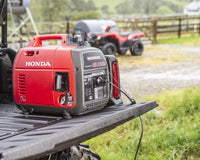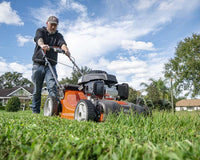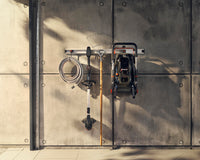A snug-fitting helmet is crucial to a successful motorcycle ride.
Here is our step by step Helmet Fitting 101 guide to ensure your next helmet is the perfect one.
1: Measurement
Start the process by measuring your head to find the circumference. We suggest you measure the circumference of your head 2cm above your eyebrows. Take several measurements - it is best to use the largest one.
It is important to note that everyone is different, and that includes head size and shape. Different models cater to different head shapes. We suggest trying on a range of brands if possible.
2: Try it on
If you are local, feel free to pop in and one of our team will help find your perfect fit.
Start by pulling the chin straps away from the helmet. As far as you can.
Place the helmet on your head, with chin straps still pulled away from the helmet. If the helmet sliiiides onto your head, covering your eyes, it is too large. The helmet should fit snug, with your eyes sitting near the center of the helmet's visor port.
For those with longer hair, try wearing your hair in a low bun, or down, when trying on (and riding with) a helmet. A high bun or ponytail will impact your fitment, and can cause you to select an incorrect size.
To make online shopping a breeze, we have created sizing charts for your favourite helmet brands: Fox, Shoei, MT, ONEAL. We also offer exchanges and returns should your helmet fit incorrectly.
3: Secure the helmet by the strap
Securing your helmet by the strap is so important that we think it deserves its own step. An unsecured helmet is as useless as a tyre with no tread.
You need to know how the helmet moves once it's strapped to your head. Take both hands and rock the helmet back and forth - is it moving? Try a size down, there should be no movement. The idea is to move the helmet, not your head!
Using another person, get them to try knock the helmet off in an upward position, by grabbing the chin bar. If the helmet is sliding around on your head, go down a size or two. If its tight, bear in mind the cheek pads and liner do break in over time.
If your helmet fits properly, only the helmet will move, not your cheeks!
3: Check your pressure points
Unfasten the helmet, and remove.
Identify the key pressure points on your face. Do you remember if they caused discomfort when wearing the helmet? Place the helmet back on and pay attention to the points. If you experience pain, size up, or try another helmet. Pain is a sign of an incorrect fit.
The common pressure points are at the forehead, and the temple. If you experience skin dents (or lines) after having the helmet on - it may be too tight and not suitable for you.
Now, your cheeks will squish up when trying on a helmet for the first time. This is normal, as these helmets are brand new. These are not classed as pressure points - just a part of the helmet fitting process.
4: Pick your Model
Now you have established your size, you can start choosing models and colours! Make sure you browse our extensive Off-Road, Road or Adventure ranges to help you enjoy the ride safely, and in style.
5: Listen to yourself
As we've explained earlier, every head is different and it's important to choose a helmet that feels good to you. Some helmets have a rounder crown shape, others are more oval. The most important piece of the helmet-fitting puzzle is to choose a helmet that feels right when you put it on. Sometimes this means swapping brands or trying different models to make sure you're happy with the fit and feel of your new helmet.
This guide should give a good understanding of the basics of helmet fitment. We want you to safely enjoy the ride for many years to come! As always, feel free to get in touch if you have any questions - our team are always happy to talk through the different options.






